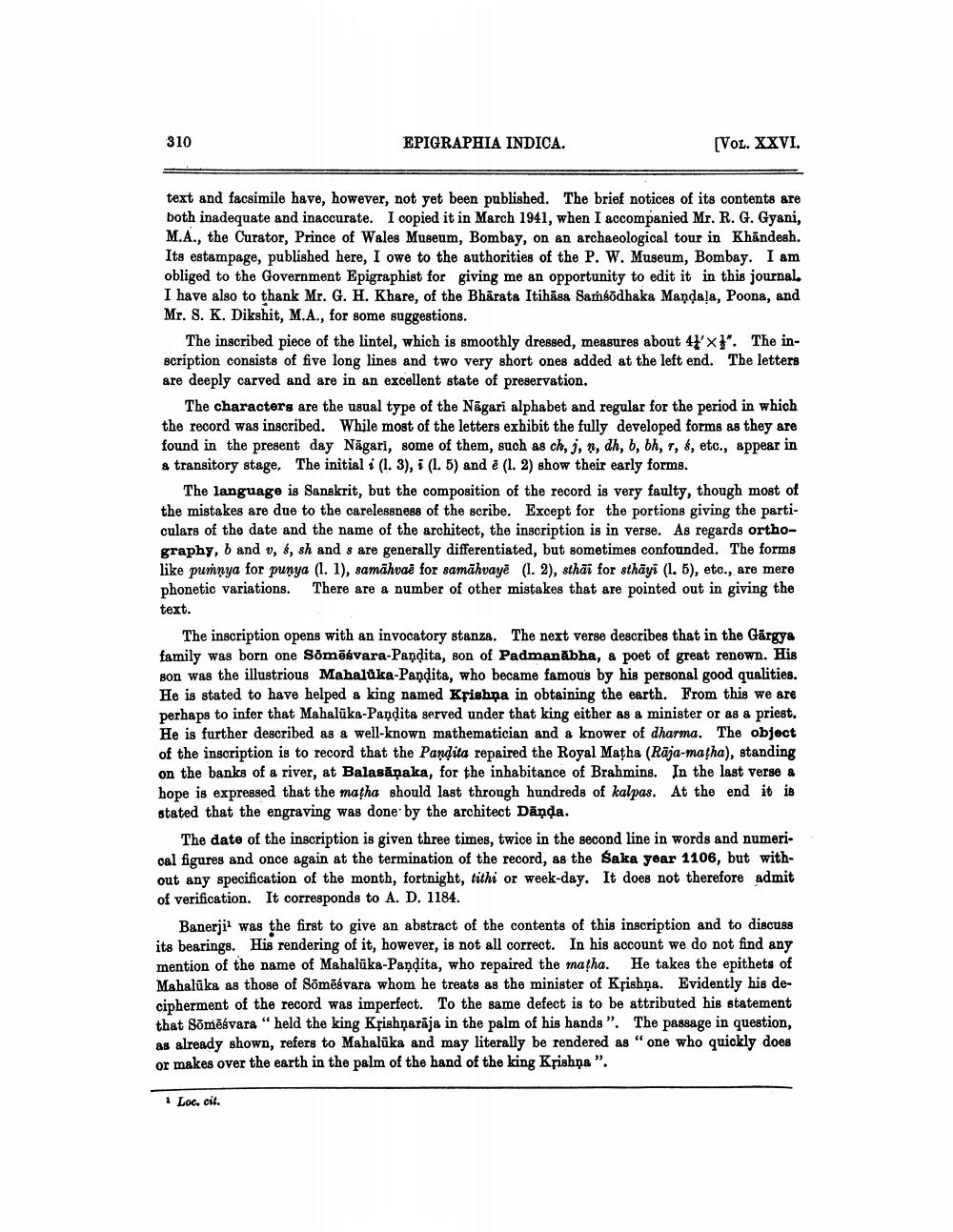________________
310
EPIGRAPHIA INDICA.
[Vol. XXVI.
text and facsimile have, however, not yet been published. The brief notices of its contents are both inadequate and inaccurate. I copied it in March 1941, when I accompanied Mr. R. G. Gyani, M.A., the Curator, Prince of Wales Museum, Bombay, on an archaeological tour in Khandesh. Its estampage, published here, I owe to the authorities of the P. W. Museum, Bombay. I am obliged to the Government Epigraphist for giving me an opportunity to edit it in this journal I have also to thank Mr. G. H. Khare, of the Bhārata Itihāsa Sambödhaka Mandala, Poona, and Mr. S. K. Dikshit, M.A., for some suggestions.
The inscribed piece of the lintel, which is smoothly dressed, measures about 4+x}". The inscription consists of five long lines and two very short ones added at the left end. The letters are deeply carved and are in an excellent state of preservation.
The characters are the usual type of the Nāgari alphabet and regular for the period in which the record was inscribed. While most of the letters exhibit the fully developed forms as they are found in the present day Nagari, some of them, such as ch, j, , dh, b, bh, 1, $, etc., appear in a transitory stage. The initial i (1. 3), 1 (1. 5) and 2 (1. 2) show their early forms.
The language is Sanskrit, but the composition of the record is very faulty, though most of the mistakes are due to the carelessness of the scribe. Except for the portions giving the particulars of the date and the name of the architect, the inscription is in verse. As regards orthography, b and v, 6, sh and 8 are generally differentiated, but sometimes confounded. The forms like pumnya for punya (1. 1), samāhvaē for samāhvayê (1.2), sthāi for sthāyī (1.5), etc., are mere phonetic variations. There are a number of other mistakes that are pointed out in giving the text.
The inscription opens with an invocatory stanza. The next verse describes that in the Gargya family was born one Somēśvara-Pandita, son of Padmanabha, & poet of great renown. His son was the illustrious Mahalüka-Pandita, who became famous by his personal good qualities. He is stated to have helped a king named Krishna in obtaining the earth. From this we are perhaps to infer that Mahalüka-Pandita served under that king either as a minister or as a priest. He is further described as a well-known mathematician and a knower of dharma. The object of the inscription is to record that the Pandita repaired the Royal Matha (Raja-matha), standing on the banks of a river, at Balasāņaka, for the inhabitance of Brahmins. In the last verse a hope is expressed that the matha should last through hundreds of kalpas. At the end it is stated that the engraving was done by the architect Dānda.
The date of the inscription is given three times, twice in the second line in words and numerical figures and once again at the termination of the record, as the Saka year 1106, but without any specification of the month, fortnight, tithi or week-day. It does not therefore admit of verification. It corresponds to A. D. 1184.
Banerjit was the first to give an abstract of the contents of this inscription and to discuss its bearings. His rendering of it, however, is not all correct. In his account we do not find any mention of the name of Mahalüka-Pandita, who repaired the matha. He takes the epithets of Mahalūka as those of Sõmēsvara whom he treats as the minister of Krishna. Evidently his decipherment of the record was imperfect. To the same defect is to be attributed his statement that Sõmēsvara "held the king Krishnarāja in the palm of his hands". The passage in question, as already shown, refers to Mahalūka and may literally be rendered as "one who quickly does or makes over the earth in the palm of the hand of the king Krishna ".
1 Loc. cit.




